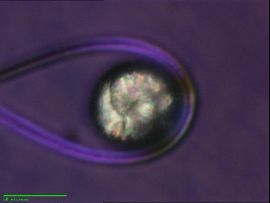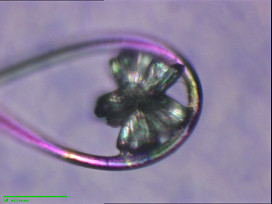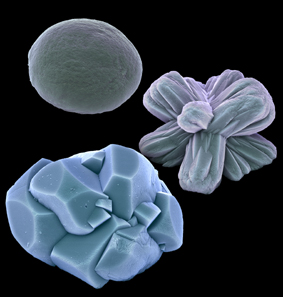- Home
- News
- General News
- Secrets of Fish...
Secrets of Fish Orientation Revealed at the ESRF
27-10-2003
Scientists from the Max Planck Institute and the ESRF1 have teamed up to study how a single gene in fish influences the biomineralisation2 of otoliths. The stone-like otoliths are located in the fish's inner ear and are involved in the balance and hearing processes. The previously unknown gene has been given the name starmaker as a reduction of its activity results in star-like otoliths. Humans have a similar gene, which is also implicated in hearing, as well as teeth formation. Synchrotron light was used to uncover changes occurring in the structure of otoliths following gene alteration. An article on this research was recently featured on the cover of Science magazine under the title: "Control of crystal size and lattice formation by starmaker in otolith biomineralization" (Science, Vol. 302, 282-286 (2003)).
Share
  |
|
Otoliths are normally round stone-like structures. After the reduction of activity of the gene, they become star-shaped crystals. The pictures were recorded with the microscope of the beamline microgoniometer. They are kept within standard Nylon loops, which are also used to support protein single crystals. |
The experiment consisted of reducing the activity of the starmaker gene and hence its encoded protein in order to see how it influenced the otolith formation in zebra fish. As a result of this modification, their otoliths, which are normally smooth, round, stone-like structures became elaborate star-shaped crystals. That is the reason why the gene has been named starmaker. Synchrotron radiation experiments showed that this change is also associated with a change in calcium carbonate crystal structure. After the reduction of starmaker activity, most of the fish had difficulty in orienting themselves quickly in fast-moving water. This is the first time a change in the otolith has been induced and tested for behavioural defects in live animals.
The team of researchers used X-ray microdiffraction3 techniques developed for protein crystallography at the microfocus beamline at the ESRF. The experiment was performed on different types of otoliths of less than 30 microns diameter. The goal was to determine which crystal polymorph was present in each type of otolith. The impressive issue is that just by modifying one single gene, there was a change of the calcium carbonate polymorphs at room temperature. "This is an important breakthrough and there are currently many teams of different scientific fields working in this kind of biomineralisation experiments. The final aim is to develop artificial materials based on information from biological systems, that is, to mimic nature", explains Christian Riekel, the scientist responsible for the microfocus beamline and one of the authors of the article.
The reason for studying this gene is because it is a counterpart of the human gene responsible for hearing loss and teeth formation (DSPP or dentin sialophosphoportein). Both of them encode many negatively-charged aminoacids, although they have a different structure. In humans, "the mutation of the DSPP protein is probably involved in biomineralization of teeth in a similar way that starmaker mediates crystal formation in otoliths", Teresa Nicolson, the principal investigator, explains to Science.
 |
Scanning electron microscopy images of zebrafish inner ear otoliths depicting the changes induced upon reduction of starmaker activity. Credits: Oregon Health & Science University. |
If you need a higher resolution of images, contact Montserrat Capellas, ESRF press officer, tel. +33 476 88 26 63 ( )
)
1 The European Synchrotron Radiation Facility (ESRF) is an international facility with 17 participating countries to operate, maintain and develop a synchrotron radiation source and associated instruments. It operates the most powerful third generation synchrotron radiation source in Europe (www.esrf.fr).
How the synchrotron works: Electrons emitted by an electron gun are first accelerated in a linear accelerator (linac) and then transmitted to a circular accelerator (booster synchrotron) where they are accelerated to reach an energy level of 6 billion electron-volts (6 GeV). These high-energy electrons are then injected into a large storage ring -844 metres in circumference- where they circulate in a vacuum environment, at a constant energy, for many hours.The synchrotron beams emitted by the electrons are directed towards the "beamlines" which surround the storage ring in the experimental hall. Each beamline is designed for use with a specific technique or for a specific type of research. Experiments run throughout the day and night.
2 What is biomineralization? Crystalline materials formed in living organisms often do not resemble their synthetic counterparts in morphology and physical properties. Although these materials have the same basic structure, they can have a different shape and strength because the organism controls their crystal morphology. Teeth, bones, kidney stones, mussels are all examples of biomineralisation. If scientists knew how to mimic nature, biologically inspired materials could be used in fields such as the development of replacements of teeth, bones, tissues, etc.
3 What is diffraction: When a beam of X-rays illuminates a crystal, it is scattered. Each atom in the crystal becomes the source of a weak amplitude wave propagating in all directions, and these waves interfere with each other. As a result, most of the scattering is cancelled and only discrete diffraction spots are observed. These spots can be recorded by a detector and are used for determining the atomic structure of the crystal.



